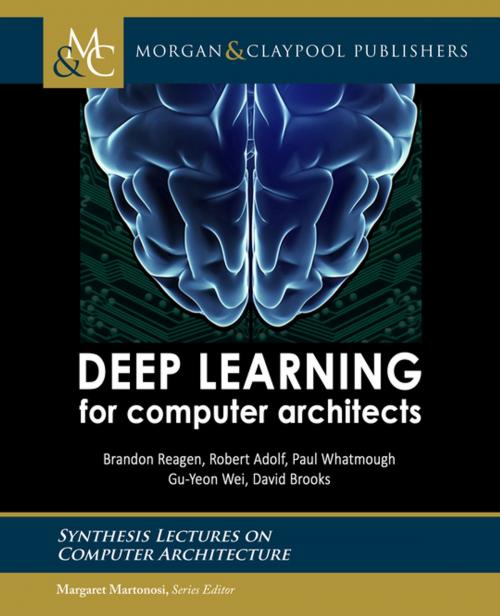Deep Learning for Computer Architects
Nonfiction, Computers, Advanced Computing, Engineering, Neural Networks, Computer Architecture, Artificial Intelligence| Author: | Brandon Reagen, Robert Adolf, Paul Whatmough, Gu-Yeon Wei, David Brooks, Margaret Martonosi | ISBN: | 9781681731728 |
| Publisher: | Morgan & Claypool Publishers | Publication: | August 22, 2017 |
| Imprint: | Morgan & Claypool Publishers | Language: | English |
| Author: | Brandon Reagen, Robert Adolf, Paul Whatmough, Gu-Yeon Wei, David Brooks, Margaret Martonosi |
| ISBN: | 9781681731728 |
| Publisher: | Morgan & Claypool Publishers |
| Publication: | August 22, 2017 |
| Imprint: | Morgan & Claypool Publishers |
| Language: | English |
Machine learning, and specifically deep learning, has been hugely disruptive in many fields of computer science. The success of deep learning techniques in solving notoriously difficult classification and regression problems has resulted in their rapid adoption in solving real-world problems. The emergence of deep learning is widely attributed to a virtuous cycle whereby fundamental advancements in training deeper models were enabled by the availability of massive datasets and high-performance computer hardware.
This text serves as a primer for computer architects in a new and rapidly evolving field. We review how machine learning has evolved since its inception in the 1960s and track the key developments leading up to the emergence of the powerful deep learning techniques that emerged in the last decade. Next we review representative workloads, including the most commonly used datasets and seminal networks across a variety of domains. In addition to discussing the workloads themselves, we also detail the most popular deep learning tools and show how aspiring practitioners can use the tools with the workloads to characterize and optimize DNNs.
The remainder of the book is dedicated to the design and optimization of hardware and architectures for machine learning. As high-performance hardware was so instrumental in the success of machine learning becoming a practical solution, this chapter recounts a variety of optimizations proposed recently to further improve future designs. Finally, we present a review of recent research published in the area as well as a taxonomy to help readers understand how various contributions fall in context.
Machine learning, and specifically deep learning, has been hugely disruptive in many fields of computer science. The success of deep learning techniques in solving notoriously difficult classification and regression problems has resulted in their rapid adoption in solving real-world problems. The emergence of deep learning is widely attributed to a virtuous cycle whereby fundamental advancements in training deeper models were enabled by the availability of massive datasets and high-performance computer hardware.
This text serves as a primer for computer architects in a new and rapidly evolving field. We review how machine learning has evolved since its inception in the 1960s and track the key developments leading up to the emergence of the powerful deep learning techniques that emerged in the last decade. Next we review representative workloads, including the most commonly used datasets and seminal networks across a variety of domains. In addition to discussing the workloads themselves, we also detail the most popular deep learning tools and show how aspiring practitioners can use the tools with the workloads to characterize and optimize DNNs.
The remainder of the book is dedicated to the design and optimization of hardware and architectures for machine learning. As high-performance hardware was so instrumental in the success of machine learning becoming a practical solution, this chapter recounts a variety of optimizations proposed recently to further improve future designs. Finally, we present a review of recent research published in the area as well as a taxonomy to help readers understand how various contributions fall in context.















